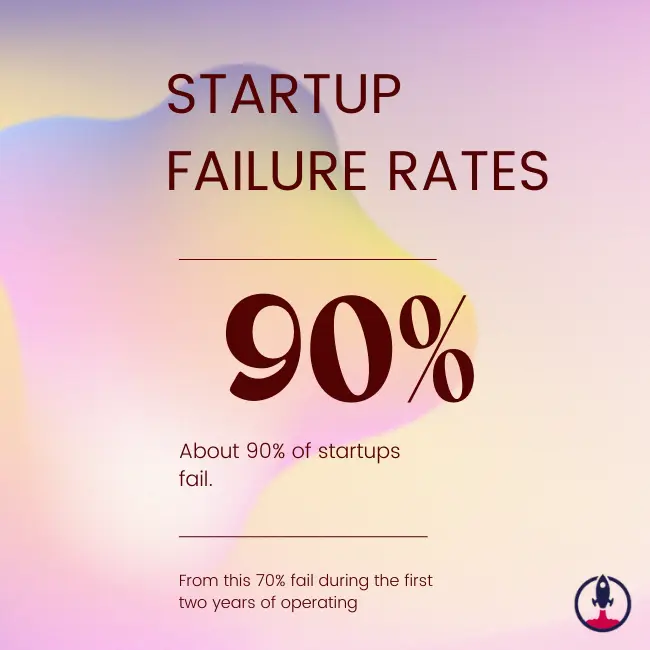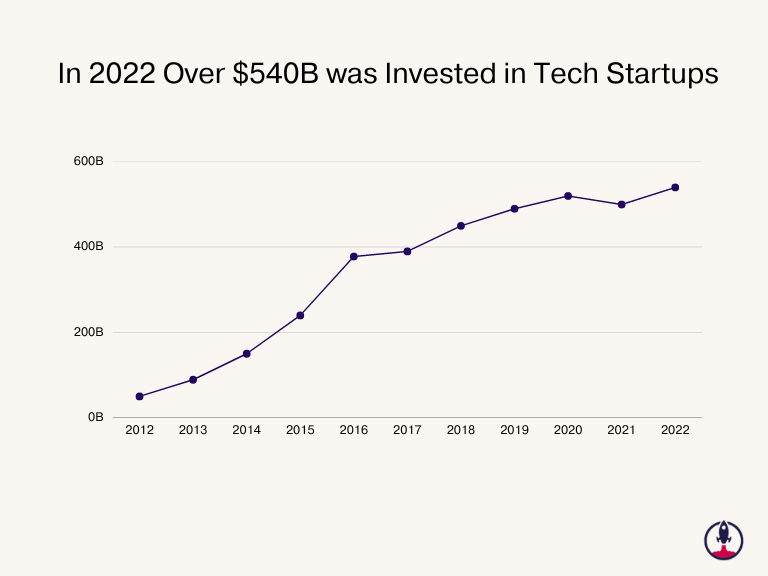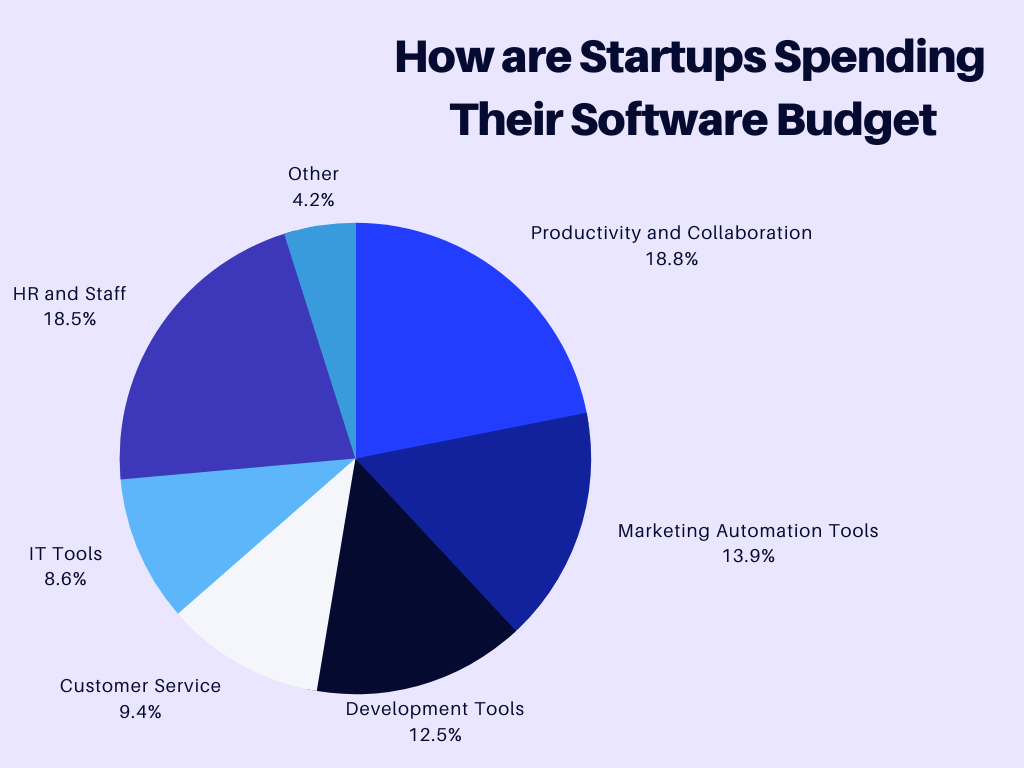Startup Funding: What It Is, How It Works, & Tips for Landing It
Approximately 90% of startups experience failure, with a whopping 49% failing due to misconceptions about market demand. Another substantial factor; 29% of failures, is either running out of personal funds or mishandling funding.
In this post, we’ll dive into exploring startup funding, learning types of startups, and effective acquisition strategies. I will also give you some inspiration and share the 2023 startups that secured 1 million in funding.
What Is Startup Funding or Startup Capital?
Startup funding is also known as startup capital. It is the financial support that a new business or startup venture needs to start operating. I started my introduction with statistics on startups that fail, for over 29% of startups, this funding is vital because most startups face significant upfront costs before they can generate revenue and become self-sustaining.
If you are still wondering is startup funding essential? In 78% of cases, startups miss revenue to direct it towards product development and improvement. Rising startup funding capital helps to establish a business without worrying about limited resources. Collaborative efforts show better results and help startups grow faster.
How Startup Funding Works?
There are 3 main startup funding categories; self-funding, investor contributions, and small-business loans.
What is Self-funding in Startup funding?
Self-funding is also known as bootstrapping. This is when the startup founder uses his/her personal resources to leverage the business. It can also be turning to family or friends or using your own savings accounts. The key point is that you are the 100% owner of your business. Finally, this way you minimize the risks of losing your business․ The reason is that you are the person responsible for all the business decisions as well as handling the staffing, stocks, operational costs, etc.
Self-funding a startup has its advantages. However, it’s also important to consider the potential drawbacks. Here are some cons of self-funding:
You can run out of money before even getting there!
Depending only on your personal savings or resources can be risky. As I have said, Startups need to pay a lot of attention to customer feedback, adapt to their needs, and constantly improve. And all of it often requires more capital than initially anticipated, and if your personal funds are depleted before your business gains traction, you might find yourself unable to cover essential expenses.
Expertise is expensive!
Another important thing for startup growth is a strong network and seeking individuals who share your vision and are willing to invest their time and expertise in exchange for future rewards. When self-funding you might not be able to afford highly experienced and expertised individuals. However, if you are able to tap into talent that believes in your idea and is willing to contribute without an immediate hefty salary, you could win the deal.
It’s hard to form a brand identity for the press with limited resources!
Bootstrapped startups often lack the spotlight of the press. Unlike venture-capital-backed counterparts, bootstrapped founders find themselves in the shadows. It’s hard to secure a place in dominating tech startup press.
This affects their ability to attract top talent, secure partnerships, and establish credibility within the industry. The lack of financial resources can limit their marketing efforts, blocking the potential to reach a broader audience and capture the attention that could prospect their growth.
What are investor contributions in Startup Funding
Investor contributions in startup funding refer to the financial support provided by individuals or entities (investors) to early-stage businesses during various funding rounds. These rounds are structured stages of fundraising that startups go through to secure the capital they need for growth and development. There are levels of funding rounds; pre-seed funding, seed funding, series A funding, series B funding, and series C funding. Those rounds represent different milestones in a startup’s journey and correspondingly attract different types of investors.
Let’s quickly go through the stages of investors’ funding rounds.
What is Pre-seed funding?
Pre-seed funding is close to bootstrapping with the difference that it’s not an actual path you choose to grow your business. It’s just an early stage of fundraising, where startup founders use their personal savings or money from friends and family to develop their business idea into a viable concept.
What is Seed Funding?
Seed funding is the first round of actual formal fundraising, where there is official paperwork involved. Investors at this stage can include angel investors, venture capital firms, and sometimes even early-stage institutional investors. Seed funding helps startups develop their products, validate their market, and build a solid foundation. And if you got confused with all the terminology here, keep reading to learn more about the funding types.
What is Series A funding?
When Seed Funding is complete and all the funds successfully help the startup to develop the product, identify the target market, and to set the tone for further business development, founders move to the series A funding. This round involves a larger infusion of capital to scale operations, expand market reach, and enhance their product or service. Series A investors often include venture capital firms looking for promising growth opportunities.
What is series B funding?
Series B funding comes into play when a startup has achieved significant growth. This growth includes a sizable client and user base and a proven business model. Finally, this round helps fuel further expansion, enter new markets, and invest in startup tools for more advanced research and development.
What is Series C funding?
At the series C stage, startups have usually established themselves as competitive players in their industry. Series C funding aims to provide the capital for additional scaling. At this stage, the startup funding helps to position the market as a solid business with potential mergers and acquisitions.
In some cases, startups might proceed with additional funding rounds such as series D and E. These rounds are typically for startups that require substantial resources for global expansion, strategic initiatives, or further diversification. For most cases, these fundings work for startups that also can be referred to as mature businesses, with a goal to create new products, to expand and scale up to global markets.
What are small-business loans in Startup funding?
Small-business loans in startup funding are financial arrangements where new businesses secure funds from lenders to cover various expenses related to starting and growing their operations.
According to the Fed Small Business’s 2023 Firms in Focus report, a significant portion of companies that are under 2 years old utilized loans to address both operating expenses and expansion needs in the year 2022. The best advantage that businesses get with startup loans is upfront cash.
There are several ways to take a business loan. The first are traditional banks, and there are also online loan lenders that are willing to extend loans to startups. Online vendors often take those calculated risks of lending money to startups based on their potential.
The most suitable startup business loans are for companies with a limited operating history and credit track record. Such loans come with specific conditions and requirements. In exchange for providing funding to startups with less established business profiles, lenders may ask for substantial collateral to secure the loan or impose a higher interest rate. These additional stipulations help reduce the lender’s increased risk exposure.
Now before breaking down funding types let’s understand whether or not your business is qualified as a startup.
What businesses are defined as Startups?
Now, before applying for any type of funding you might wonder, Is my business qualified as a startup?
For the most part, the qualifiers of startup businesses depend on the industry, context, years in business, etc. However, there are still several criteria. Let’s quickly go through some of them:
Innovation is a key component of a startup, the main idea of startups is to either create a completely new market or to make innovations in the existing markets. So one thing that your business absolutely needs in order to be qualified as a startup is the unique idea behind it, that brings value to the existing markets.
Flexibility in terms of business operation. Startups need to align and adapt to changes in the market. Especially in the first several months of running user feedback is very important to improve and set a business strategy that will be long term.
The term “startup” can be used to describe businesses in their early stages, even if they have been operating for a couple of years, as long as they represent innovation, growth potential, and pursuit of game-changing ideas, they can be qualified as startups.
How to get startup funding?
The first and foremost step is to thoroughly understand your business operations. Craft a comprehensive business plan to enhance your chances of attracting funds. A well-structured plan demonstrates a thoughtful explanation of your idea and helps you to address questions confidently. Companies with set business plans also tend to experience higher growth rates.
Here’s why a business plan is crucial:
It is the Foundation for Funding: Investors require a solid business plan as a prerequisite for providing funds. Utilize a business plan template to start outlining your venture. Here are the 5 best startup business plant temples to use as examples.
Future Revenue and Expense Statement: Most investors will require financial projections before considering an investment. It is the accurate projections of future cash inflows and outflows. This gives investors an idea of how you are planning to repay the investment, business loan, etc.
Clear Description: Define your business clearly: who you are and what you do. This concise yet informative overview is crucial for potential investors’ understanding.
Market Analysis: Analyze your market, studying both competitors and your target audience. As mentioned at the start of this article, nearly 49% of businesses fail because of misunderstanding the market demand. Such insights are also invaluable for attracting investors who grasp your market understanding.

Organizational Structure: Outline your company’s structure, designating roles and responsibilities. Clearly defined managerial and operational positions showcase your business’s stability.
The step two is to understand what type of funding your startup needs. So for that, let’s take a quick dive into startup funding types.
What are the types of startup funding?
Now let’s go through some of the most popular startup funding types and get to know the basics. Keep in mind that each of these fundings has its own advantages, requirements, and considerations. So before making a decision make sure you are aware of all the risks that come with each of the types. Diversifying funding sources and carefully evaluating the terms and implications of each option are crucial steps in securing the right type of capital for a startup’s unique needs. Your startup may need tools for IT professionals for effective management of technological infrastructure and operations.
Venture Capital (VC) Funding:
Venture capital involves investment from professional investment firms or venture capitalists. These investors provide capital to startups in exchange for equity ownership. Venture capitalists typically target high-potential, high-growth startups with innovative products or services and significant market potential.
VC is growing very fast, and over the last decade, it reached over 4 times growth. The leading companies that get VC funding are tech companies; according to Dealroom.co, in 2022 over $540B was invested in tech companies.

Angel Investors:
Angel investors are individuals who provide their personal funds to startups in exchange for equity or convertible debt. They often invest in early-stage startups and can offer not only financial support but also valuable mentorship and industry connections.
Crowdfunding Platforms:
Crowdfunding involves raising small amounts of money from a large number of people, typically through online platforms. There are different models of crowdfunding, including rewards-based crowdfunding (backers receive products or perks), equity crowdfunding (investors get equity), and donation-based crowdfunding (donations without equity or rewards).
Bootstrapping:
As discussed earlier in the article, bootstrapping refers to the practice of funding a startup using personal savings. It can also be the revenue generated by the business itself and other minimal external capital. Bootstrapped startups maintain full ownership and control but may face limitations in terms of growth speed and scale. Revise this by clicking here.
Incubators and Accelerators:
These are programs designed to support startups in their early stages. Incubators provide resources like office space, mentorship, and networking opportunities. On the other hand, accelerators offer a more intense program focused on rapid growth. It can be in a form of a demo day where startups pitch to investors.
Private Equity Firms:
This time is more common in the later stages of a company’s growth. Private equity firms can provide substantial funding to established startups or mature companies. They often seek majority ownership and actively participate in the management of the business.
Alternative Funding Sources – Grants, Loans, etc
Startups can explore various alternative funding options, including government grants, research grants, and subsidies. Let’s go through some of the alternatives to the mentioned types.
Strategic Partnerships and Corporate Investments: Some startups seek funding through strategic partnerships with established companies or corporations. These partnerships can provide not only capital but also access to resources, expertise, and potential distribution channels.
Initial Coin Offerings (ICOs) and Token Sales: These are more common in the blockchain and cryptocurrency space.ICOs issue tokens or coins to raise funds for a project. Investors buy these tokens with the expectation of future value appreciation or utility within the project’s ecosystem. Bitcoin and NFTs are classic examples.
Grants and Competitions: Startups can also apply for grants from government agencies, non-profit organizations, and private foundations.
Convertible Notes and SAFE Agreements: These are debt-like or equity-like instruments used in early-stage fundraising. Convertible notes and Simple Agreement for Future Equity (SAFE) agreements allow startups to raise funds with the promise of converting the investment into equity at a later funding round.
Once you set a clear business plan and understand which type of startup funding is perfect for your market, it is time to understand how to negotiate the terms with potential investors and choose the most favorable option. This brings us to our next subject which is…
How can startups negotiate favorable deal terms?
Negotiating favorable deal terms for a startup requires a strategic approach that balances flexibility, professionalism, and a clear understanding of your value. Here’s how startups can navigate the negotiation process effectively:
Strive for a Win-Win:
Approach negotiations with the mindset that both parties should benefit. A win-win outcome fosters goodwill and cooperation. This will enhance the likelihood of a successful deal.
Explore Various Compensation Forms:
Be open to diverse forms of compensation, including cash, stock, earn-outs, and retention bonuses. This flexibility can lead to creative solutions that satisfy both sides.
Realistic Valuation:
Avoid overestimating or underestimating your value or market demand. Thoroughly research your industry and consult experts to come to a reasonable valuation.
Emotion Management:
Keep emotions and ego in check during negotiations. Emotional reactions can hinder productive discussions. Maintain a professional demeanor to build trust.
Compromise and Concession:
Be willing to compromise on non-essential points to demonstrate your flexibility. However, stand firm on aspects critical to your interests.
Clear Term Sheet:
Create a comprehensive written term sheet outlining key terms and conditions. This establishes a foundation for negotiations and minimizes misunderstandings.
Legal Expertise:
Engage an experienced legal team to review and negotiate contracts. Their insights ensure that the terms are fair and entertain your interests.
Backup Plan:
Develop a plan B or a walk-away point in case negotiations fail or the deal collapses. Alternatives prevent being cornered into unfavorable terms.
Communication and Transparency:
Maintain open and transparent communication throughout the negotiation process. This builds trust and reduces misunderstandings.
Long-Term Relationship:
Consider the potential for future collaboration or partnerships. A respectful and professional approach can lead to positive relationships beyond the deal.
Market Research:
Gather data about recent deals in your industry to benchmark your negotiations. This provides insights into prevailing terms and market expectations.
Patience:
Negotiations can be lengthy. Maintain patience and don’t rush into agreements that don’t align with your goals.
Due Diligence:
Conduct thorough due diligence to verify the other party’s claims and information. This minimizes uncertainty and exposure, increasing your negotiating leverage. As this is by far one of the most essential points let’s also briefly understand…
What is the due diligence process?
The due diligence process is a comprehensive investigation and evaluation of the startup funding. Usually, one party; such as a potential investor, buyer, or merger partner assesses the accuracy of the information that the other party provides and uncovers any potential risks, issues, or opportunities associated with a business transaction. It’s a critical step before finalizing any significant business deal, such as an investment, acquisition, merger, or partnership.
The goal of due diligence for startup funding is to ensure that both parties have a clear and accurate understanding of the assets, liabilities, financial health, medical health, healthcare, legal status, operations, and overall condition of the entity being examined. This process helps manage potential risks and ensures that the transaction is conducted on informed and transparent grounds, incorporating a revenue projection model to forecast future financial performance accurately.
I hope you manage to successfully go through all this process, and come to the final step; managing startup funds.
How do startups spend their funding?
You might think that getting funding for your startup is the final step, but in fact, it’s only the start. It is crucial to understand how to allocate acquired funds effectively. Let’s break down where your funds must be directed so that the funding you get promotes startup growth.

Marketing and Sales:
You should allocate a significant portion of the budget to marketing and sales efforts. This is especially important for attracting customers, creating brand awareness, and driving revenue growth.
- Marketing: Allocate funds for various marketing strategies, such as digital advertising, content creation, social media campaigns, and branding initiatives. Effective marketing helps startups reach their target audience and generate leads.
- Sales: Invest in building a capable sales team, and equipping them with the necessary tools and resources to convert leads into customers. This includes sales training, CRM systems, and sales automation tools.
Salaries and Operational Expenses:
Ensuring that your team is well-compensated is crucial for talent retention and motivation. Allocate funds for salaries, benefits, and other employee-related expenses. Additionally, investing in essential operational tools, such as transaction monitoring software, is vital for managing financial transactions efficiently, ensuring compliance, and safeguarding against fraud. This includes covering day-to-day operational costs like office rent, utilities, and software subscriptions.Also, make sure to cover day-to-day operational costs like office rent, utilities, and software subscriptions.
Growth Initiatives:
Prioritize growth-oriented activities that expand your customer base and market reach.
The allocation of funds may vary based on the startup’s stage of growth, industry, and specific business goals. However, you must regularly review and adjust your budget allocations based on performance and market trends. These were just the 3 most important points, a well-balanced allocation strategy aligns with your startup’s growth trajectory and strategic priorities.
To Sum up
I did my best, to sum up all the key factors to help you start your funding process and choose the right strategy along the way. Make sure to read more about startup funding, best loan companies, funding strategy, etc on our blog.
- YouTube Optimization in 2024: TubeMagic VS VidIQ - July 10, 2024
- How SaaS Solutions Can Improve Remote Work Efficiency - June 22, 2024
- How to Build a LinkedIn Marketing Strategy for SaaS Startups - June 21, 2024


